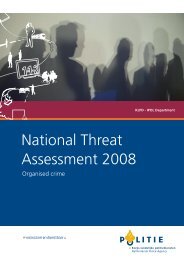Assessing the Effectiveness of Organized Crime Control Strategies ...
Assessing the Effectiveness of Organized Crime Control Strategies ...
Assessing the Effectiveness of Organized Crime Control Strategies ...
You also want an ePaper? Increase the reach of your titles
YUMPU automatically turns print PDFs into web optimized ePapers that Google loves.
<strong>Assessing</strong> <strong>the</strong> <strong>Effectiveness</strong> <strong>of</strong> <strong>Organized</strong> <strong>Crime</strong> <strong>Control</strong> <strong>Strategies</strong>:<br />
A Review <strong>of</strong> <strong>the</strong> Literature<br />
over <strong>the</strong> telephone and in meetings, <strong>the</strong>re is a minimum <strong>of</strong> written communications that can be<br />
used to construct a paper trail <strong>of</strong> criminal transactions (Kenney and Finckenauer, 1995:337).<br />
Despite <strong>the</strong> value <strong>of</strong> electronic surveillance, it constitutes a considerable invasion <strong>of</strong> privacy and<br />
hence must be governed by strict regulations in non-totalitarian societies. The extensive<br />
surveillance <strong>of</strong> civil rights leader Martin Lu<strong>the</strong>r King, Jr., in <strong>the</strong> 1960s, is just one example <strong>of</strong> <strong>the</strong><br />
potential abuse <strong>of</strong> this investigative tool for political or o<strong>the</strong>r ends (Krajick, 1983:30).<br />
Aside from concerns about <strong>the</strong> civil liberties <strong>of</strong> targets, <strong>the</strong> use <strong>of</strong> electronic surveillance is<br />
limited by its prohibitive cost. In <strong>the</strong> US, <strong>the</strong> cost per tap has risen from an average <strong>of</strong> $5,524 in<br />
1970 to $46,492 in 1992 (Albanese, 1996:177). This elevated cost is partly due to regulations in<br />
<strong>the</strong> US that require <strong>the</strong> presence <strong>of</strong> a police <strong>of</strong>ficer who must listen to <strong>the</strong> beginning <strong>of</strong> each<br />
conversation and turn <strong>of</strong>f <strong>the</strong> recorder, if <strong>the</strong> conversation is not related to <strong>the</strong> eavesdropping<br />
warrant. Also, tapes must be transcribed, conversations analyzed, and leads provided by <strong>the</strong><br />
intercept must be followed-up through physical surveillance and o<strong>the</strong>r means. Fur<strong>the</strong>rmore,<br />
material from electronic intercepts <strong>of</strong>ten must be enhanced by specialists to reduce background<br />
noise (Abadinsky, 2003:347).<br />
There are o<strong>the</strong>r practical problems associated with surveillance, as well as problems in<br />
interpreting material that has been intercepted. Schlegel (1988) points out that <strong>the</strong> planning <strong>of</strong><br />
conspiratorial acts takes a considerable amount <strong>of</strong> time and <strong>of</strong>ten occurs in a variety <strong>of</strong> locations,<br />
<strong>the</strong>reby undermining <strong>the</strong> utility <strong>of</strong> electronic eavesdropping. There are also problems in<br />
interpreting conversations (e.g., a “hit” can refer to a murder or robbery) and in <strong>the</strong> validity <strong>of</strong><br />
what people are overheard to say, as <strong>the</strong>y may be lying or bragging.<br />
In <strong>the</strong> US, <strong>the</strong> use <strong>of</strong> court-authorized electronic surveillance has grown measurably from 1970<br />
to <strong>the</strong> 1990s (Albanese, 1996:175). Telephone taps have been <strong>the</strong> most popular means <strong>of</strong><br />
surveillance, although interceptions <strong>of</strong> electronic communications have grown perceptibly since<br />
<strong>the</strong> late 1980s. The average length <strong>of</strong> surveillance operations has doubled from 19 to 38 days.<br />
Surveillance now is more likely to be used in drug and racketeering cases, but less <strong>of</strong>ten in<br />
gambling cases, reflecting <strong>the</strong> changing priorities <strong>of</strong> US law enforcement agencies (Albanese,<br />
1996:176).<br />
Albanese (1996:177) has found that three times as many conversations were intercepted in 1992<br />
as in 1970, but that <strong>the</strong> percent <strong>of</strong> conversations containing incriminating information dropped<br />
from 45 percent to 19 percent during that same period. He interprets this finding to mean that<br />
crimes may be less conspiratorial and hence may produce fewer conversations that are crimerelated.<br />
Or, alternatively, <strong>the</strong> cases selected for surveillance are becoming less appropriate.<br />
Ano<strong>the</strong>r possibility is that <strong>the</strong>re may be a saturation point beyond which surveillance is no longer<br />
useful in investigations. It may also be <strong>the</strong> case that members <strong>of</strong> criminal organizations are more<br />
aware that <strong>the</strong>ir communications may be intercepted by law enforcement are <strong>the</strong>refore more<br />
prudent with <strong>the</strong>ir communications.<br />
The analysis conducted by Albanese indicates that <strong>the</strong> number <strong>of</strong> arrests and convictions arising<br />
from electronic surveillance in <strong>the</strong> US has increased from 1970 to 1992, although <strong>the</strong> number <strong>of</strong><br />
arrests and convictions per tap has remained fairly stable. The National Wiretap Commission, a<br />
46 | Research and Statistics Division / Department <strong>of</strong> Justice Canada








